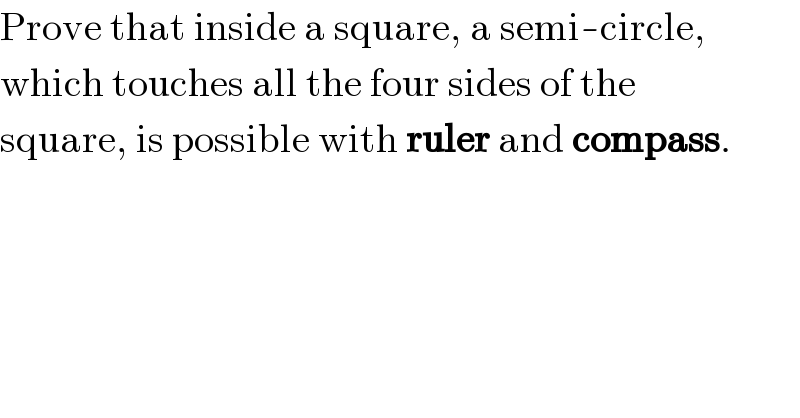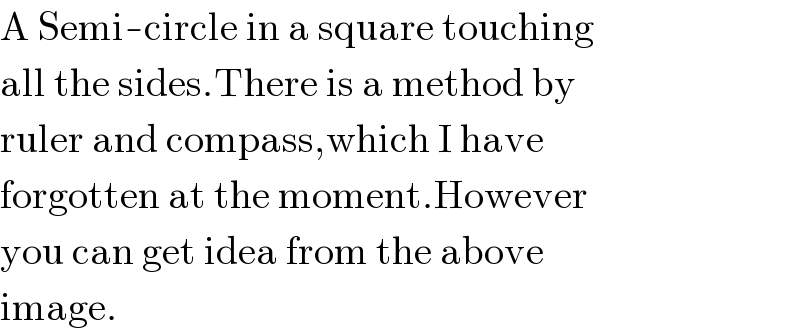Question Number 4080 by Rasheed Soomro last updated on 27/Dec/15

$$\mathrm{Prove}\:\mathrm{that}\:\mathrm{inside}\:\mathrm{a}\:\mathrm{square},\:\mathrm{a}\:\mathrm{semi}-\mathrm{circle}, \\ $$$$\mathrm{which}\:\mathrm{touches}\:\mathrm{all}\:\mathrm{the}\:\mathrm{four}\:\mathrm{sides}\:\mathrm{of}\:\mathrm{the} \\ $$$$\mathrm{square},\:\mathrm{is}\:\mathrm{possible}\:\mathrm{with}\:\boldsymbol{\mathrm{ruler}}\:\mathrm{and}\:\boldsymbol{\mathrm{compass}}. \\ $$
Commented by Rasheed Soomro last updated on 29/Dec/15

$$\mathrm{A}\:\mathrm{Semi}-\mathrm{circle}\:\mathrm{in}\:\mathrm{a}\:\mathrm{square}\:\mathrm{touching} \\ $$$$\mathrm{all}\:\mathrm{the}\:\mathrm{sides}.\mathrm{There}\:\mathrm{is}\:\mathrm{a}\:\mathrm{method}\:\mathrm{by} \\ $$$$\mathrm{ruler}\:\mathrm{and}\:\mathrm{compass},\mathrm{which}\:\mathrm{I}\:\mathrm{have}\: \\ $$$$\mathrm{forgotten}\:\mathrm{at}\:\mathrm{the}\:\mathrm{moment}.\mathrm{However} \\ $$$$\mathrm{you}\:\mathrm{can}\:\mathrm{get}\:\mathrm{idea}\:\mathrm{from}\:\mathrm{the}\:\mathrm{above} \\ $$$$\mathrm{image}. \\ $$
Answered by Rasheed Soomro last updated on 30/Dec/15

$$\mathrm{First}\:\mathrm{I}\:\mathrm{write}\:\:\mathrm{ruler}\:\mathrm{and}\:\mathrm{compass}\:\mathrm{method}\:\mathrm{of} \\ $$$$\mathrm{the}\:\mathrm{required}\:\mathrm{figure},\:\mathrm{then}\:\mathrm{I}'\mathrm{ll}\:\mathrm{prove}\:\mathrm{the}\:\mathrm{method}. \\ $$$$\mathrm{Pl}\:\mathrm{see}\:\mathrm{the}\:\mathrm{image} \\ $$$$\mathrm{ABCD}\:\mathrm{is}\:\mathrm{a}\:\mathrm{given}\:\mathrm{square}.\:\angle\mathrm{DBC}\:\mathrm{has}\:\mathrm{been} \\ $$$$\mathrm{bisected}.\mathrm{Let}\:\mathrm{the}\:\mathrm{bsector}\:\mathrm{meets}\:\mathrm{the}\:\mathrm{side}\:\mathrm{DC} \\ $$$$\mathrm{at}\:\mathrm{E}. \\ $$$$\angle\mathrm{DBC}\:\mathrm{is}\:\mathrm{one}\:\mathrm{of}\:\mathrm{eight}\:\boldsymbol{\mathrm{diagonal}}-\boldsymbol{\mathrm{side}}\:\boldsymbol{\mathrm{angles}}. \\ $$$$\mathrm{You}\:\mathrm{can}\:\mathrm{select}\:\mathrm{any}\:\mathrm{angle}\:\mathrm{to}\:\mathrm{bisect}\:\mathrm{it}. \\ $$$$\mathrm{From}\:\mathrm{E}\:\mathrm{a}\:\mathrm{line}\:\parallel\:\mathrm{BC}\:\mathrm{has}\:\mathrm{been}\:\mathrm{drawn}\:\mathrm{that} \\ $$$$\mathrm{met}\:\mathrm{diagonal}\:\mathrm{BD}\:\mathrm{at}\:\mathrm{F}.\:\mathrm{F}\:\mathrm{is}\:\mathrm{center}\:\mathrm{of}\:\mathrm{required} \\ $$$$\mathrm{semi}-\mathrm{circle}.\:\mathrm{Through}\:\mathrm{F}\:\mathrm{a}\:\mathrm{line}\:\mathrm{segment}\:\mathrm{GH}\: \\ $$$$\mathrm{parallel}\:\mathrm{to}\:\mathrm{diagonal}\:\mathrm{AC}\:\mathrm{has}\:\mathrm{been}\:\mathrm{drawn}.\:\mathrm{GH}\:\mathrm{is} \\ $$$$\mathrm{diameter}\:\mathrm{of}\:\mathrm{the}\:\mathrm{semi}-\mathrm{circle}.\mathrm{Taking}\:\mathrm{center}\:\mathrm{F} \\ $$$$\mathrm{and}\:\mathrm{radius}\:\mathrm{equal}\:\mathrm{to}\:\mathrm{FG}\:\mathrm{or}\:\mathrm{FH}\:\mathrm{or}\:\mathrm{FE},\:\mathrm{required} \\ $$$$\mathrm{semi}-\mathrm{circle}\:\mathrm{has}\:\mathrm{been}\:\mathrm{drawn}. \\ $$$$\mathrm{PROOF}\blacktriangleright\:\mathrm{Without}\:\mathrm{the}\:\mathrm{loss}\:\mathrm{of}\:\mathrm{generality},\:\mathrm{let}'\mathrm{s} \\ $$$$\mathrm{assume}\:\mathrm{that}\:\mathrm{side}\:\mathrm{of}\:\mathrm{the}\:\mathrm{given}\:\mathrm{square}\:\mathrm{is}\:\mathrm{unity} \\ $$$$\therefore\:\mathrm{Each}\:\mathrm{diagonal}\:\mathrm{is}\:\sqrt{\mathrm{2}}. \\ $$$$\:\:\:\:\:\:\mathrm{Semi}-\mathrm{circle}\:\mathrm{touches}\:\mathrm{all}\:\mathrm{the}\:\mathrm{sides}\:\mathrm{of}\:\mathrm{square}. \\ $$$$\mathrm{We}'\mathrm{ll}\:\mathrm{prove}\:\mathrm{its}\:\mathrm{being}\:\mathrm{touched}\:\mathrm{for}\:\mathrm{two}\:\mathrm{consecutive} \\ $$$$\mathrm{sides}\:\mathrm{BC}\:\mathrm{and}\:\mathrm{CD}\:\:\mathrm{in}\:\mathrm{this}\:\mathrm{proof}\:\mathrm{Touching}\:\mathrm{other} \\ $$$$\mathrm{two}\:\mathrm{sides}\:\mathrm{is}\:\:\mathrm{easy}\:\mathrm{to}\:\mathrm{prove}. \\ $$$$\:\:\:\:\:\bigtriangleup\mathrm{BEC}\:\mathrm{is}\:\mathrm{aright}\:\mathrm{angled}\:\mathrm{triangle}\:,\:\mathrm{in}\:\mathrm{which} \\ $$$$\angle\mathrm{BCE}=\pi/\mathrm{2}\:,\:\angle\mathrm{EBC}=\pi/\mathrm{8}\:\:\mathrm{and}\:\:\mathrm{BC}=\mathrm{1} \\ $$$$\mathrm{tan}\:\angle\mathrm{EBC}=\mathrm{EC}/\mathrm{BC}\:\:\Rightarrow\:\mathrm{EC}=\mathrm{tan}\:\left(\pi/\mathrm{8}\right)=\sqrt{\mathrm{2}}−\mathrm{1} \\ $$$$\mathrm{So},\:\:\:\:\:\:\mathrm{EC}=\sqrt{\mathrm{2}}−\mathrm{1} \\ $$$$\mathrm{Now}\:\mathrm{DE}=\mathrm{CD}−\mathrm{EC}\:\Rightarrow\mathrm{DE}=\mathrm{1}−\left(\sqrt{\mathrm{2}}−\mathrm{1}\right)=\mathrm{2}−\sqrt{\mathrm{2}} \\ $$$$\mathrm{Or}\:\:\:\:\:\:\:\mathrm{DE}=\mathrm{2}−\sqrt{\mathrm{2}} \\ $$$$\bigtriangleup\mathrm{DEF}\:\mathrm{is}\:\mathrm{a}\:\mathrm{right}\:\mathrm{angled}\:\mathrm{triangle},\:\mathrm{in}\:\mathrm{which} \\ $$$$\angle\mathrm{FDE}=\pi/\mathrm{4}\:,\angle\mathrm{DFE}=\pi/\mathrm{4}\left(\angle\mathrm{DFE}\:\mathrm{is}\:\mathrm{complement}\right. \\ $$$$\left.\mathrm{of}\:\angle\mathrm{FDE}\right) \\ $$$$\because\:\mathrm{Two}\:\mathrm{angles}\:\mathrm{are}\:\mathrm{equal} \\ $$$$\therefore\:\mathrm{EF}=\mathrm{DE}=\mathrm{2}−\sqrt{\mathrm{2}}…………………………….\mathrm{I} \\ $$$$\mathrm{sin}\:\angle\mathrm{FDE}=\mathrm{EF}/\mathrm{DF}\:\Rightarrow\mathrm{sin}\left(\pi/\mathrm{4}\right)=\left(\mathrm{2}−\sqrt{\mathrm{2}}\:\right)/\mathrm{DF} \\ $$$$\frac{\mathrm{1}}{\:\sqrt{\mathrm{2}}}=\frac{\mathrm{2}−\sqrt{\mathrm{2}}}{\mathrm{DF}}\Rightarrow\mathrm{DF}=\mathrm{2}\sqrt{\mathrm{2}}−\mathrm{2} \\ $$$$\mathrm{Now}\:\mathrm{BF}=\mathrm{BD}−\mathrm{DF}=\sqrt{\mathrm{2}}−\left(\mathrm{2}\sqrt{\mathrm{2}}−\mathrm{2}\right)=\mathrm{2}−\sqrt{\mathrm{2}} \\ $$$$\:\:\:\:\:\:\:\:\:\:\:\:\:\mathrm{BF}=\mathrm{2}−\sqrt{\mathrm{2}} \\ $$$$\:\:\:\:\:\mathrm{In}\:\:\bigtriangleup\mathrm{BFG},\:\:\angle\mathrm{FBG}=\angle\mathrm{FGB} \\ $$$$\:\:\:\:\:\:\:\:\:\:\:\:\:\:\:\:\:\:\therefore\:\:\mathrm{GF}=\mathrm{BF}=\mathrm{2}−\sqrt{\mathrm{2}}……………………\mathrm{II} \\ $$$$\mathrm{From}\:\mathrm{I}\:\&\mathrm{II} \\ $$$$\:\:\:\:\:\:\:\:\:\:\:\:\:\:\:\:\:\:\:\mathrm{EF}=\mathrm{GF}=\mathrm{2}−\sqrt{\mathrm{2}} \\ $$$$\mathrm{Semi}-\mathrm{circle}\:\mathrm{touches}\:\mathrm{DC}\:\:\mathrm{and}\:\mathrm{BC} \\ $$$$\mathcal{QED} \\ $$
Answered by Rasheed Soomro last updated on 29/Dec/15

Commented by Rasheed Soomro last updated on 30/Dec/15

$$\mathrm{Actually}\:\mathrm{the}\:\mathrm{paper}\:\mathrm{was}\:\mathrm{white}\:\mathrm{and}\:\mathrm{new}\:\mathrm{but} \\ $$$$\mathrm{the}\:\mathrm{photo}\:\mathrm{seems}\:\mathrm{as}\:\mathrm{old}\:\mathrm{as}\:\mathrm{if}\:\mathrm{it}\:\mathrm{were}\:\mathrm{taken} \\ $$$$\mathrm{two}\:\mathrm{centuries}\:\mathrm{ago}!\:\mathrm{So}\:\mathrm{your}\:\mathrm{advice}\:\mathrm{is}\:\mathrm{very} \\ $$$$\mathrm{right}. \\ $$
Commented by Yozzii last updated on 29/Dec/15

$${If}\:{you}'{d}\:{like}\:{to}\:{make}\:{pictures}\:{like} \\ $$$${these}\:{more}\:{defined}\:{with}\:{a}\:{more}\:{white} \\ $$$${background},\:{try}\:{using}\:{the}\:{app}\:{called} \\ $$$${CamScanner}.\:{That}'{s}\:{what}\:{I}\:{used}\:{to} \\ $$$${to}\:{produce}\:{the}\:{pictures}\:{for}\:{some}\: \\ $$$${questions}\:{I}\:{shared}\:{recently}. \\ $$
Commented by RasheedSindhi last updated on 30/Dec/15

$$\mathrm{Thanks}.\:\mathrm{I}'\mathrm{ll}\:\mathrm{try}.\: \\ $$
